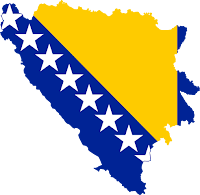 |
| Source: Wikimedia Commons |
In the aftermath of the war, the educational system in Bosnia and Herzegovina was marked by uncertainties and endless debates leading to an impasse. Originally, the schools were established on mono-ethnic and mono-national grounds that became unsustainable when refugees from several neighboring ex-Yugoslav states started to migrate back to their homes after 1997. After the Dayton Agreement, a new constitution was implemented, but it created a decentralized, asymmetric, and largely defective management system for education that mirrors the insoluble political situation plagued with multi-ethnic and multi-religious conflicts in major cities, such as Sarajevo, Tuzla, Mostar, and Zenice (Fox, Kreso, and Majhanovich, 2008). The new system has undermined unity in policies, goals, values, and patriotic feelings for the new state (Jozić 2012).
One of the direct consequences of decentralization was, for instance, the bourgeoning of parallel state institutions that lead to the establishment of 13 constitutions and, among others, 13 ministries of education (two entity level ministries, 10 cantonal ministries, and the ministry of the Brcko District). The educational system in particular is monopolized by the nationalist leaderships of Bosnian Croats, Bosnian Serbs, and Bosniaks, aiming at controlling their share of the educational process. Ignoring past mistakes in the 90s, schools in Bosnia Herzegovina have been characterized as “two schools under one roof” (Perry, 2003:29): there are Bosniaks schools teaching the Bosnian language, Croatian schools for Bosnian Croat children studying the Croatian language written with the Latin alphabet, and Serbian schools with Serbian pupils studying from books written with the Cyrillic alphabet. Compromises often lead to absurd scenarios, such as the story of a new school built with World Bank funds in the town of Stolac (Perry 2003:30):
Bosnian Croat children attended the new school, while Bosniak children were forced to be schooled out of private homes in sub-standard conditions. Upon hearing of this egregious situation, the OHR (the Office of the High Representative in Bosnia) stepped in and said that if space in the new school was available (and it was), the Bosniak children should be able to benefit from the World Bank project as well. While a good intention, the OHR underestimated the divisions in Stolac and the nationalist politics that drive the [‘hardliner’] city in Herzegovina. Rather than integrating the Bosniak children into the school, the school was essentially divided into Bosnian Croat and Bosniak sections, separating students by floor, with piles of chairs and desks serving as barriers in the corridors and with separate entrances for each group.
Neither the international community nor any of the domestic leadership-governments (Republika Srpska in Banja Luka or the government of the Federation of Croats and Muslims in Sarajevo) has been able find a way out of the deadlock. The situation has had a profound impact on the fragile state of Bosnia and Herzegovina, especially on younger generations who are prevented from reconciling the past and, as the motto of the European Union would want it, live “united in their diversity”.
In recent times, there have been positive developments. The Declaration on the Common Language in Sarajevo by Croatian, Bosnian, and Serbian NGOs in late March 2017 represents a new attempt at bringing together the different cultures in the region. In this Declaration, thee NGOs especially urge to silence the independent nationalisms of the three main ethnicities for the benefit of the education of new generations. The NGOs asked the authorities to consider the fact that the purportedly different Bosnian, Croatian, and Serbian languages are differentiated politically but not linguistically: despite regional differences, the three languages remain mutually intelligible and are commonly referred to as the BCS (Bosnian, Croatian, and Serbian) languages. Predictably, this request was greeted with a wide variety of emotions. Some of the political analysts and linguists in the region welcomed the proposal for a common post-Yugoslav language federating between Croatian, Bosnian, and Serbian, while others disapproved. Among the loudest opponents of this proposal seem to have been translators, whose profession may be endangered with the possible unification of the languages.
In my opinion, the proposal for a common post-Yugoslav language was a remarkable step forward. It was initiated through the reasonable examination of civil societies and their immediate needs in the region and, as such, it should be welcomed and received with greater attention from the international community, particularly the European Union, as well. More precisely, EU officials could use the common post-Yugoslav language proposal as a tool for calming down nationalistic feelings and pretensions. It might be wise to envision using it as a ‘carrot mechanism’ in the EU conditionality for accession of states like Bosnia and Herzegovina.
REFERENCES CITED AND CONSULTED:
Busch Brigitta, Schick, Jurgen. “Educational materials reflecting Hetergdossia: Disidventing Ethnolinguistic Differences in Bosnia and Herzegovina”, Fond otvoreno drustvo, Bosna and Herzegovina, Sarajevo, 2012.
Busek, Erhard, Kuhne, Bjorn. “From Stabilization to Integration- The Stability Pact for South Eastern Europe”, Brussels, SEETO, 2010.
Fox Christine, Kreso, Pasalic, Adila, Majhanovich, Suzanne. “Living Together- Education and Intercultural Dialogue”, Springer Science+Business Media, B.V, 2009.
Jozic, Zeljko. “Linguistic (Un)reality in Contemporary Bosnia and Herzegovina ”. University of Helsinki, Department of Languages. Helsinki, 2005.
Majstorović, Danijela, Vučkovac, Zoran. “Rethinking Bosnia and Herzegovina’s post-coloniality Challenges of Europeanization discourse”. Journal of Language and Politics 15:2 (2016), 147–172. doi 10.1075/jlp.15.2.02maj issn 1569–2159 / e-issn 1569–9862 © John Benjamins Publishing Company.
Perry, Valery. “Reading, Writing and Reconciliation: Educational Reform in Bosnia and Herzegovina”. European Center for Minority Issues (ECMI) Working Paper # 18, September 2003.
---
Marija was a visting student in Political Science from the Master’s program in Inter-disciplinary Research and Studies of Eastern Europe at the University of Bologna in Italy when she wrote this text in 418 ‘Language and Minorities in Europe’ at the University of Illinois in spring 2017.








